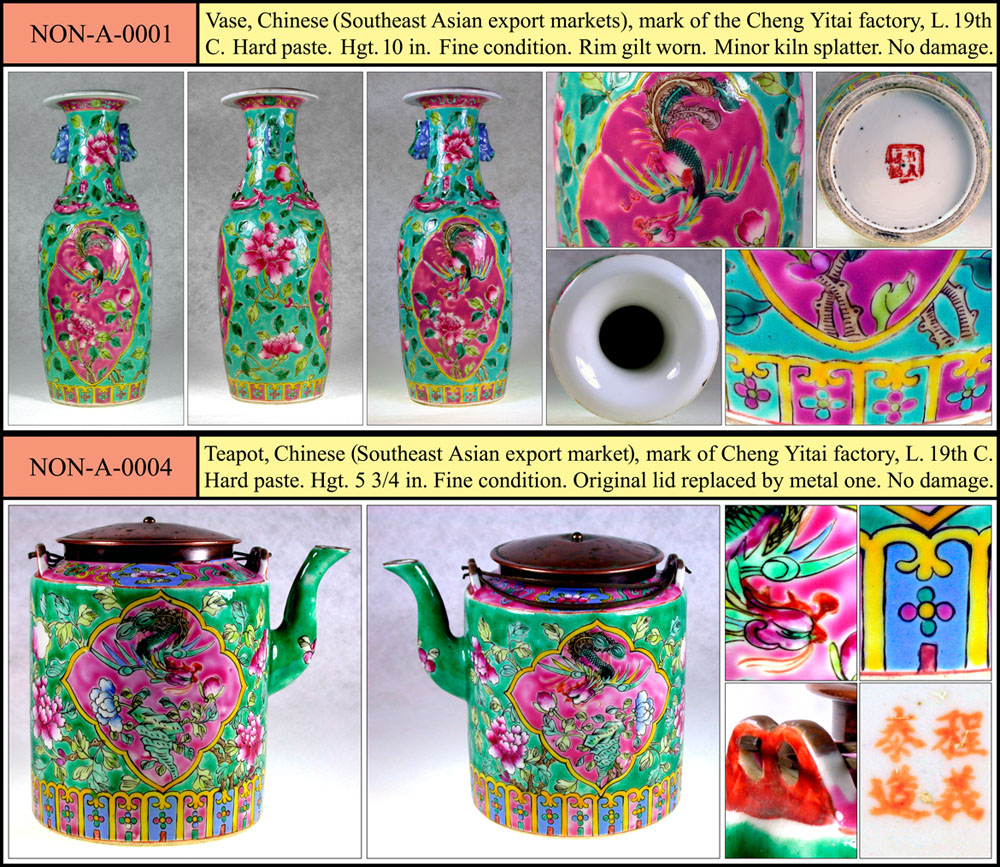
|
Subject:Re: Peranaken Kamcheng
Posted By: Bill H Sat, Sep 14, 2019
In his book 'Straits Chinese Porcelain-A Collector's Guide', Dr. Ho Wing Meng captioned his Fig, 3 illustration as follows:
'A pair of milk jugs potted in European style. The decorative motifs are, however, in Straits Chinese taste. Notice that the uneven and mottled texture of the enamels and the somewhat shoddy painting indicated that these milk jugs are of the Min Kuo* period.' *Republic Period
In my opinion, some of the same things might be said about the weak enamels and painting on your Kamcheng. Baba-Nonya culture by and large doted on the strong colors in most of their favorite patterns.
In Volume 13, No. 2 (April 2006 ), of the Mainland Journal 'China Ceramic Industry', the matter of quality in Nonya wares was touched on in the following terms (my translation follows from the Chinese, which I'll be happy to add here if anyone wishes):
Usually, a set of Nonya/Nyonya porcelain is composed of hundreds to thousands of pieces of various sizes, many of which pieces often vary in quality for two reasons: First is because the sets of porcelain were so large, they had to be made by several porcelain makers, each of which usually made the wares in their own workshop, resulting in various marks such as "Made by Zhou Shunxing", "Wang Shengtai"*, "Cheng Yitai", "Xu Shunchang", "Cao Shuntai", and so on (excluding family marks), so the quality of the porcelain inevitably varied. Second is that due to losses from normal wear and tear, quantities would become insufficient for use, so new porcelain had to be added, and this replenishment also was inconsistent in quality.
*Corrected from Wang Shengsu
In the abstract for the preceding 2006 journal article, it also was stated:
Nonya wares, large quantities of which have only been found in Southeast Asia, are a type of famille rose porcelain ware particularly ordered from China during the late Qing Dynasty and the early period of the Chinese Republic by native-born Chinese in the areas across the Straits of Malacca. Though with distinctive features, they have been long neglected by ceramic researchers in China. This paper describes the backgrounds, decorations and shapes of Nonya wares as a genre
strange to contemporary Chinese as an initiative for their further study in this field.
In my opinion, contemporary Chinese artisans and potters at Jingdezhen and possibly elsewhere appear to have accepted the challenge inherent in the preceding initiative and probably are still sorting out their quality issues. I looked around online and found Nonya wares in the same form and quality, with the same 'Made by Xu Shunchang' mark, the only difference being that it was in a different style of standard characters than the example in Dr. Ho's book.
Below are a couple of items by Cheng Yitai that have graced my collection in years past. I believe they're both late 19th century, but the teapot probably is closer to the end of the Qing Dynasty. I might have called it Republic had the mauve enamels been as thin as on yours, but not with its form and the remainder of its decoration remaining quite true to 19th century norms.
Caveat emptor,
Bill H.



|
 Peranaken Kamcheng
Peranaken Kamcheng  ( China & Japan ) - Markaty - Sep 10, 2019 (03:46 PM)
( China & Japan ) - Markaty - Sep 10, 2019 (03:46 PM)  Re: Peranaken Kamcheng
Re: Peranaken Kamcheng  - Bill H - Sep 14, 2019 (04:22 AM)
- Bill H - Sep 14, 2019 (04:22 AM)  Re: Peranaken Kamcheng - Ken Yap - Dec 05, 2020 (01:43 AM)
Re: Peranaken Kamcheng - Ken Yap - Dec 05, 2020 (01:43 AM)